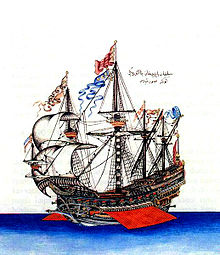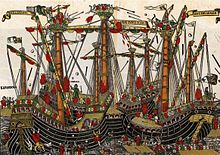Kemal Reis
[1] Kemal Reis started his career as the commander of the naval fleet belonging to the Sanjak Bey (Provincial Governor) of Eğriboz (present-day Euboea) which was under Ottoman control.
In 1487 the Ottoman Sultan Bayezid II appointed Kemal Reis with the task of defending the lands of Emir Abu Abdullah, the ruler of Granada, which was then one of the final Muslim strongholds in Spain.
Kemal Reis sailed to Spain and landed an expeditionary force of Ottoman troops at Málaga, capturing the city and the surrounding villages and taking many prisoners (see Granada War).
In 1495 Kemal Reis was made an admiral of the Ottoman Navy by Sultan Bayezid II who ordered the construction of his large flagship, Göke, which could carry 700 soldiers and was armed with the strongest cannons of that period.
In October 1496, with a force of 5 galleys, 5 fustas, a barque and a smaller ship, Kemal Reis set sail from Constantinople and raided the Gulf of Taranto.
In March 1497 Sultan Bayezid II appointed him with the task of protecting the ships which carried valuable goods belonging to the religious foundations of Mecca and Medina from the frequent raids of the Knights of St. John who were based in the island of Rhodes at that time (in 1522 the Ottomans captured Rhodes and allowed the Knights of St. John to peacefully leave the island, who first relocated their base to Sicily and later to Malta in 1530.)
In April 1498, commanding a fleet of 6 galleys, 12 fustas with large cannons, 4 barques and 4 smaller types of ships, he set sail from the Dardanelles and headed south towards the Aegean islands that were controlled by the Republic of Venice.
In July 1498 he sailed to Rosetta (Rashid) in Egypt with a force of 5 galleys, 6 fustas and 2 barques for transporting 300 Muslim pilgrims heading for Mecca, who also had with them 400,000 gold ducats which were sent to the Mamluk sultan by Bayezid II.
In January 1499 Kemal Reis set sail from Constantinople with a force of 10 galleys and 4 other types of ships, and in July 1499 met with the huge Ottoman fleet which was sent to him by Davud Pasha and took over its command in order to wage a large scale war against the Republic of Venice.
The Ottoman Sultan Bayezid II gifted 10 of the captured Venetian galleys to Kemal Reis, who stationed his fleet at the island of Cefalonia between October and December, 1499.
In September 1500 Kemal Reis assaulted Voiussa and in October he appeared at Cape Santa Maria on the Island of Lefkada before ending the campaign and returning to Istanbul in November.
In May 1501, with a force of 8 galliots and 13 fustas, he escorted the cargo ships carrying construction material for strengthening the Ottoman fortresses on the islands of Chios and Tinos, where he captured the galley of Girolamo Pisani, the local Venetian commander, including the official standard of San Marco (St. Mark, the patron saint of Venice) along with another Venetian galley named "Basadonna".
In August 1501 Kemal Reis and his troops landed at Sardinia and captured several coastal settlements while taking around 1,050 prisoners during fights against the local forces.
Still in August 1501 Kemal Reis sailed to the Balearic Islands and the Ottomans landed at Majorca, where bitter fighting against the local Spanish forces took place.
After leaving Valencia, still in August 1501, Kemal Reis headed south and bombarded the coastal defenses of Andalucia before landing his troops, where the Ottomans raided several ports and towns.
From there Kemal Reis sailed southwest and landed on several of the Canary Islands, where the Ottomans faced moderate opposition from the Spanish forces.
Piri Reis used the occasion, as in other voyages with his uncle, to draw his famous portolan charts which were later to become a part of the renowned Kitab-ı Bahriye (Book of Navigation).
However, the strategic importance of the Island of Santa Maura (as the Venetians called Lefkada) prompted the Repubblica Serenissima to organize a huge fleet under the command of Benedetto Pesaro, which consisted of 50 galleys and numerous other smaller ships.
Overwhelmed by the size of the enemy fleet, Kemal Reis was forced to abandon Lefkada and sailed back first to Gallipoli and later to Constantinople, where, in October 1502, he ordered the construction of new ships at the Imperial Naval Arsenal of the Golden Horn.
However, he was caught by a severe illness and had to return to Constantinople for treatment, which lasted a long time and caused him to remain inactive between November 1503 and March 1505.
Throughout June 1506 he raided the Dodecanese Islands before sailing back to the West Mediterranean with a fleet of 22 ships (including 3 large galleys and 11 fustas) where he landed on Sicily and assaulted the coastal settlements.
He later sailed to the Island of Cerigo in the Ionian Sea with a force of 3 galleys and 2 fustas, and exchanged fire with the Venetian fleet under the command of Girolamo Contarini.
In January 1507 Kemal Reis was appointed by Bayezid II with the task of hunting the Knights of St. John and set sail from Gallipoli with a large fleet of 15 galleys and 25 fustas that were heavily armed with cannons.
In August 1507 he sailed to Alexandria with a cargo of 8,000 sets of oars and 50 cannons that were donated to the Mamluk sultan by Bayezid II for helping him in his fight against the Portuguese fleet which often ventured into the Red Sea and damaged Mameluke interests.
Kemal Reis stayed in Egypt until February 1508, and was back in Constantinople in May 1508, where he personally coordinated the reparation and modification of his ships at the Imperial Naval Arsenal of the Golden Horn before setting sail once again towards the Aegean Sea for confronting the Venetians and the Knights of St. John.
In February 1509, accompanied by the Ottoman privateer Kurtoğlu Muslihiddin Reis (known as Curtogoli in the West) and commanding a larger fleet of 20 ships (4 galleys, 1 galleass, 2 galliots, 3 barques and 10 fustas) he assaulted the City of Rhodes and landed a large number of janissaries at the port.



